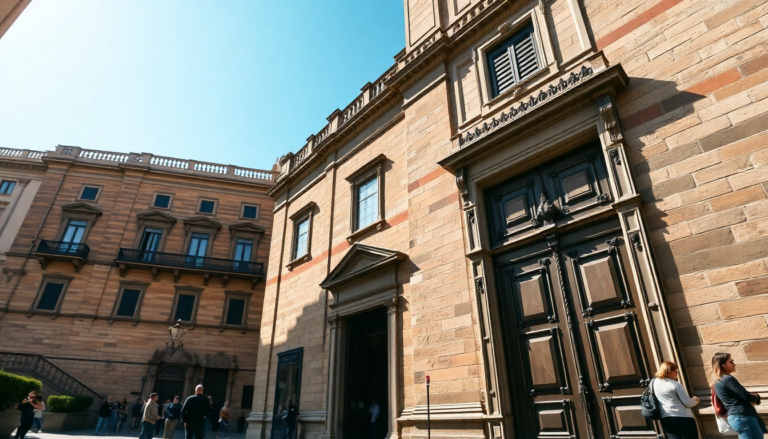Argomenti trattati
In the heart of Florence, the majestic Palazzo Vecchio stands as a testament to the city’s rich history and artistic heritage. This iconic structure, crowned with its towering fortifications, is not just a sight to behold but a gateway into the Renaissance era. With its mysterious corners and breathtaking art, Palazzo Vecchio is a place where every visitor can find something to marvel at. I remember the first time I stepped into its vast halls; the sheer magnitude of its architecture left me in awe, and each room told a story of its own.
The historical significance of Palazzo Vecchio
Dating back to the 13th century, Palazzo Vecchio has been the center of political power in Florence for centuries. Originally built as a fortress, it transformed into the town hall and later a residence for the Medici family. The building’s architecture reflects the tumultuous history of the city, from its medieval origins to the opulent Renaissance embellishments. Visitors often remark on the sense of stepping back in time as they wander through its corridors, imagining the important decisions that shaped Florence’s destiny taking place within these walls.
The grandeur of the Salone del Cinquecento
One cannot mention Palazzo Vecchio without highlighting the awe-inspiring Salone del Cinquecento. This grand hall, commissioned by Savonarola and expanded by Cosimo I de’ Medici, is nothing short of spectacular. Stretching approximately 54 meters in length, with a height that reaches 18 meters, it boasts a stunning ceiling adorned with 39 painted panels that leave visitors breathless. The walls are lined with magnificent frescoes depicting historic battles, a testament to the artistic genius of Giorgio Vasari and his workshop. It’s here that Michelangelo’s statue of ‘Il Genio della Vittoria’ captivates onlookers, adding to the hall’s grandeur. I can still recall the moment I stood there, surrounded by history, feeling the weight of the centuries in the air.
Event highlights and cultural significance
On June 9, 2025, the Salone del Cinquecento will host a remarkable event as the legendary Italian rock star Vasco Rossi receives the ancient keys to the city. This ceremony will not only celebrate Rossi’s contributions to music but also intertwine the world of contemporary culture with the historical significance of this iconic location. It’s fascinating to see how such a modern event can resonate within the walls of a palace that has witnessed the rise and fall of empires. For those who can’t attend, the event promises to be streamed live, connecting the past and present in an extraordinary way.
The Map Room and its geographical wonders
As you continue your exploration, don’t miss the impressive Sala delle Carte Geografiche, or the Map Room. This space houses a unique three-dimensional atlas from the 16th century, featuring 53 beautifully painted maps that illustrate the known world of that era. The room, designed for encyclopedic purposes, presents a fascinating insight into how geography was understood centuries ago. Standing amidst these intricate depictions, I felt a connection to the explorers of the past, imagining their adventures as they charted unknown territories.
The intimate Studiolo of Francesco I de’ Medici
Adjacent to the Map Room lies the Studiolo of Francesco I de’ Medici, a small but richly decorated chamber that served as the Grand Duke’s private retreat. Although modest in size and lacking windows, it is a treasure trove of artistic and scientific curiosities. The walls are lined with cupboards adorned with painted panels, housing rare artifacts that reflect Francesco’s eclectic interests. This intimate atmosphere, with its sense of seclusion, invites visitors to ponder the personal world of a grand duke who sought solace in knowledge and beauty.
Climbing the Torre di Arnolfo
The adventure doesn’t end inside the palace. A ticket grants access to the Torre di Arnolfo, which rises nearly 95 meters above Piazza della Signoria. The climb may be challenging, but the panoramic views of Florence from the top are well worth the effort. Gazing down at the bustling streets below, I was struck by the contrast between the city’s vibrant life and the historical calm of the tower, which once served as a prison for Savonarola. It’s a reminder that even the most beautiful places can harbor dark histories.
The Chapel of Eleonora and other highlights
Within the private apartments of Palazzo Vecchio lies the Chapel of Eleonora di Toledo, Cosimo I’s wife. Despite its modest size, the chapel features exquisite decorations by Bronzino, showcasing frescoes dedicated to the Virgin Mary and various saints. The attention to detail is nothing short of remarkable, highlighting the artistry of the time. Each brushstroke tells a story, inviting reflection on the spiritual life of the Medici family.
The Palace also features the Sala degli Elementi, dedicated to the four elements: water, air, earth, and fire. This allegorical space is adorned with stunning mythological frescoes by Giorgio Vasari, adding another layer of depth to the visitor experience. Each room in Palazzo Vecchio serves as a reminder of the city’s influential past and its artistic achievements. In my view, exploring these hidden corners is essential for anyone wanting to truly understand Florence.
Beyond the structural marvels, the museum presents a wealth of artifacts and archaeological finds that chronicle the evolution of Florentine power, particularly under the Medici dynasty. Occasionally, special tours reveal secret passages and hidden rooms, providing an exclusive glimpse into the palace’s enigmatic history. It’s experiences like these that turn a simple visit into an unforgettable journey through time.

